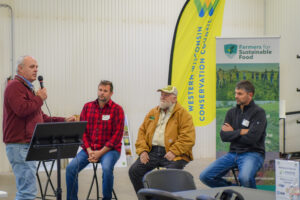Western Wisconsin farms continue to have a high interest in conservation practices and their impact on local soil health and water quality. Western Wisconsin Conservation Council (WWCC) is a group of farmers committed to stewardship of the land and water in their care. To promote farming best practices that keep soil healthy and water clean, the group highlighted local research projects on soil health and well testing, along with local farmer perspectives at the 2022 annual meeting.
This year’s meeting was held on Dec. 8. Board President Todd Doornink shared the group’s many accomplishments, including hosting three field events, launching the first year of a biological study, continuing University of Wisconsin-River Falls (UWRF) research partnerships, having a fourth successful year of a cost-share program and offering a new way to communicate with members through a texting service.
Shawn Wesener, data collection specialist with Farmers for Sustainable Food, gave an all-encompassing report on how WWCC has enhanced conservation practices over the past five years. The group has grown to 56 members, with 86% of members completing this year’s annual conservation practice survey. Some of the key takeaways were 99% of acres were soil sampled, 50% of acres were split-applied nitrogen, almost 25% of the farmers tried planting green and 61% of acres were reduced-till and no-till. These preliminary results show a great adoption rate of conservation practice across the group. The full 2022 conservation practice report will be shared with the group in early 2023.
 A neighboring watershed council, Horse Creek Area Farmer-led Watershed Council, has a plot studying conservation practices for the past eight years. Dennis Busch and Andrew Cartmill with Water Resources Monitoring Group, LLC shared some effects of agronomic practices on soil health and water quality from that plot. The treatments on the plot are no-till without cover, no-till multi-species cover, no-till cereal rye cover, conventional till cereal rye cover and conventional till no cover. Busch presented water quality data from rainfall simulations collected in the fall of 2021 and spring of 2022. The project that's funding our data collection will continue for another three years. The results so far haven’t been surprising.
A neighboring watershed council, Horse Creek Area Farmer-led Watershed Council, has a plot studying conservation practices for the past eight years. Dennis Busch and Andrew Cartmill with Water Resources Monitoring Group, LLC shared some effects of agronomic practices on soil health and water quality from that plot. The treatments on the plot are no-till without cover, no-till multi-species cover, no-till cereal rye cover, conventional till cereal rye cover and conventional till no cover. Busch presented water quality data from rainfall simulations collected in the fall of 2021 and spring of 2022. The project that's funding our data collection will continue for another three years. The results so far haven’t been surprising.
“If you reduce tillage and use cover crops, typically you're going to have less runoff. Along with that reduced runoff, you'll have lower soil erosion rates and lower phosphorus loss,” Busch said. “We saw that across the board in the plots at Horse Creek where they reduced the tillage and utilize cover crops. Typically, we had higher infiltration rates, lower runoff, and reduced soil and phosphorus losses.”
Cartmill presented some preliminary data on soil health collected in the fall of 2022. One piece he focuses on is the earthworm count, which is the earthworm population in a cubic foot of soil. The Horse Creek plot follows trends that have been well documented; the more tillage you do, the lower the population will be. With this being preliminary data, he was cautious to emphasize it. He also shared the carbon and nitrogen levels, which didn’t show much significance. He did expect levels to be higher in the no-till areas. He also mentioned lower bulk density, meaning a lower compaction rate in the no-till areas. Once they have a few more years of data, he will be able to share more comparisons and results.
WWCC’s continued partnership with UWRF provided the opportunity to hear an update on the ongoing well-testing and lysimeter research. Dr. Jill Coleman Wasik, associate professor of environmental science at UWRF, has grown her sampling effort from 45 wells in 2018 to 100 wells this past year. With a long-standing study, she can look back on wet versus dry years to see what sticks out. For example, in a wet year, she saw some of the nitrate concentrations tick upward in some of our wells. And now over these last couple of dry years, she’s seeing a tick downward in those nitrate concentrations in wells.
“This indicates or suggests that maybe at least some of the wells in the data set are responding rapidly to weather and climate. And you know, how the water is moving into the soil,” Coleman Wasik said. “There are a variety of factors that we look at when we're thinking about how susceptible is a well to something that might be coming from the surface.”
She also shared that the depth of a well can affect the results. When a nitrate doesn’t have very far to go down, it makes sense to show up in the test. When you have much deeper wells, sometimes either the nitrate takes longer to get down there or more likely that well is drawn from an aquifer where the groundwater has a much, much longer path that it's taking to move through that system. All WWCC members are added to the well-testing project. Farmers interested in getting their well tested should reach out to WWCC.
 The annual meeting also included a farmer panel discussion on “Minimum till and no-till with cover crop termination and planter attachments.” Dave Tollberg, a local agronomist, moderated the discussion with farmers Greg Friendshuh, Andy Bensend and Scott Carlson. All panelists got into conservation practices for varied reasons, and all have plans to continue doing them. Some of the biggest benefits they agree on are weed suppression, strong soil structure and water management. They also encouraged the audience to start small and try reducing tillage or planting cover crops for multiple years to see the difference.
The annual meeting also included a farmer panel discussion on “Minimum till and no-till with cover crop termination and planter attachments.” Dave Tollberg, a local agronomist, moderated the discussion with farmers Greg Friendshuh, Andy Bensend and Scott Carlson. All panelists got into conservation practices for varied reasons, and all have plans to continue doing them. Some of the biggest benefits they agree on are weed suppression, strong soil structure and water management. They also encouraged the audience to start small and try reducing tillage or planting cover crops for multiple years to see the difference.
“One of the easiest things to do to ensure success is to start small and try things out on a more limited acreage basis before you try to do the whole farm,” Bensend said. “Another piece of advice is to get yourself connected to a farmer-led watershed group that has people with experience in it and listen, watch, pay attention and attend meetings. There's a lot of help out here and there's a lot of experience that most of those guys are willing to share.”
